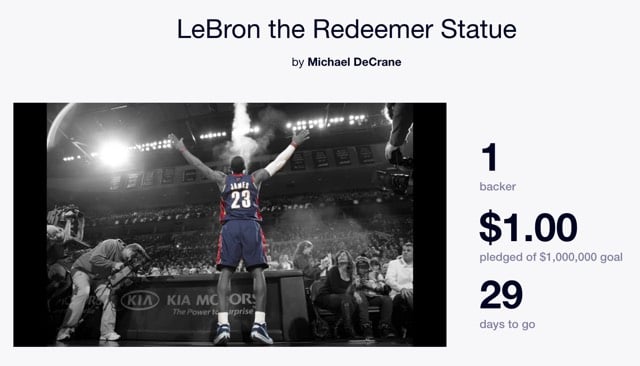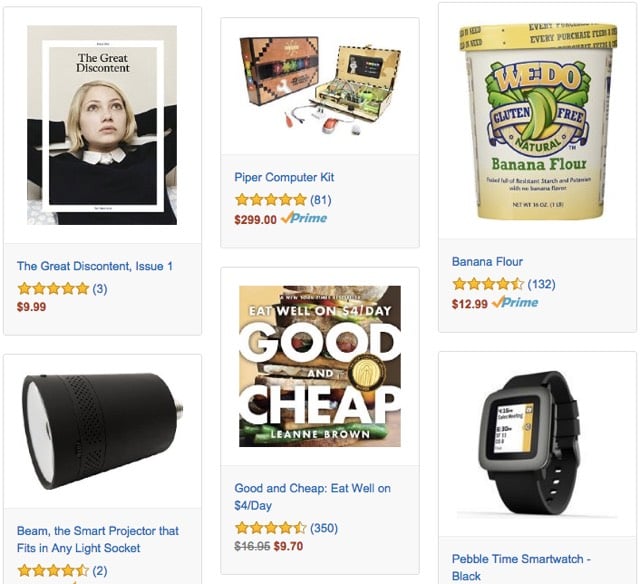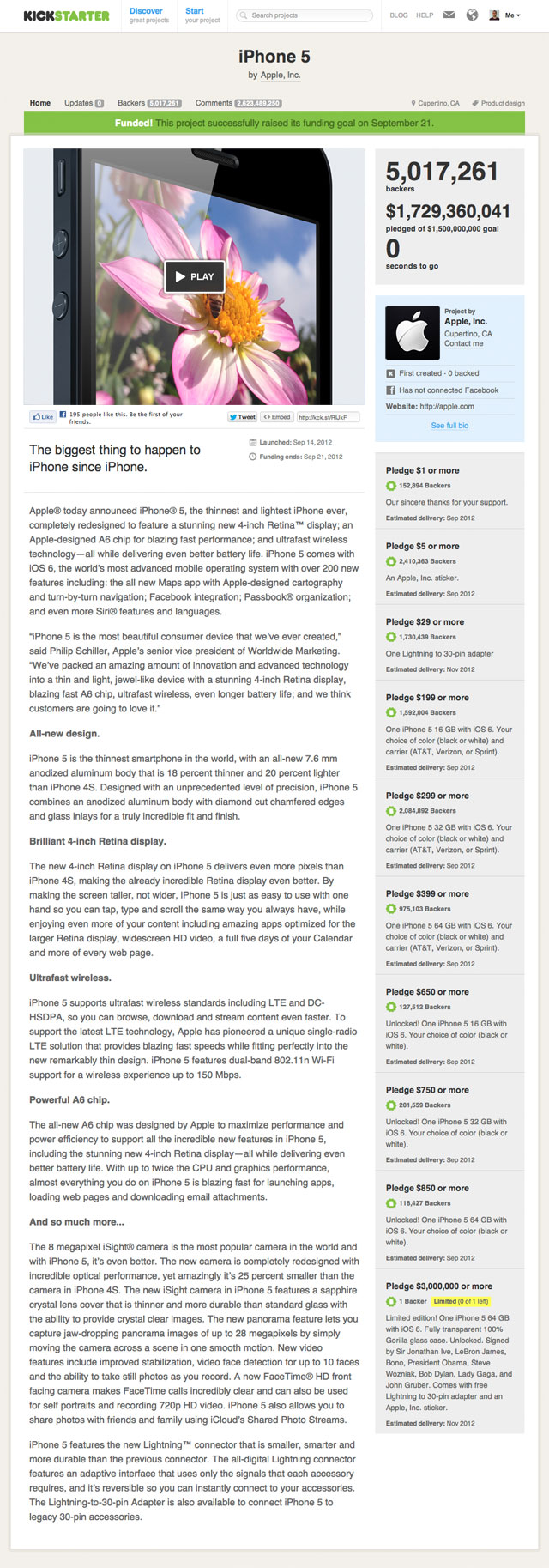kottke.org posts about Kickstarter

Writing in Wired, Craig Mod expertly dissects both the e-book revolution that never happened and the quieter one that actually did:
The Future Book was meant to be interactive, moving, alive. Its pages were supposed to be lush with whirling doodads, responsive, hands-on. The old paperback Zork choose-your-own-adventures were just the start. The Future Book would change depending on where you were, how you were feeling. It would incorporate your very environment into its story—the name of the coffee shop you were sitting at, your best friend’s birthday. It would be sly, maybe a little creepy. Definitely programmable. Ulysses would extend indefinitely in any direction you wanted to explore; just tap and some unique, mega-mind-blowing sui generis path of Joycean machine-learned words would wend itself out before your very eyes.
Prognostications about how technology would affect the form of paper books have been with us for centuries. Each new medium was poised to deform or murder the book: newspapers, photography, radio, movies, television, videogames, the internet.
That isn’t what happened. The book was neither murdered nor fundamentally transformed in its appearance, its networked quality, or its multimedia status. But the people and technologies around the book all did fundamentally change, and arguably, changed for the better.
Our Future Book is composed of email, tweets, YouTube videos, mailing lists, crowdfunding campaigns, PDF to .mobi converters, Amazon warehouses, and a surge of hyper-affordable offset printers in places like Hong Kong.
For a “book” is just the endpoint of a latticework of complex infrastructure, made increasingly accessible. Even if the endpoint stays stubbornly the same—either as an unchanging Kindle edition or simple paperback—the universe that produces, breathes life into, and supports books is changing in positive, inclusive ways, year by year. The Future Book is here and continues to evolve. You’re holding it. It’s exciting. It’s boring. It’s more important than it has ever been.
This is all clever, sharply observed, and best of all, true. But Craig is a very smart man, so I want to push him a little bit.
What he’s describing is the present book. The present book is an instantiation of the future book, in St. Augustine’s sense of the interconnectedness and unreality of the past, future, and eternity in the ephemerality of the present, sure. But what motivated discussions of the future book throughout the 20th and in the early 21st century was the animating force of the idea that the book had a future that was different from the present, whose seeds we could locate in the present but whose tree was yet to flourish. Craig Mod gives us a mature forest and says, “behold, the future.” But the present state of the book and discussions around the book feel as if that future has been foreclosed on; that all the moves that were left to be made have already been made, with Amazon the dominant inertial force locking the entire ecosystem into place.
But, in the entire history of the book, these moments of inertia have always been temporary. The ecosystem doesn’t remain locked in forever. So right now, Amazon, YouTube, and Kickstarter are the dominant players. Mailchimp being joined by Substack feels a little like Coke being joined by Pepsi; sure, it’s great to have the choice of a new generation, but the flavor is basically the same. So where is the next disruption going to come from?
I think the utopian moment for the future of the book ended not when Amazon routed its vendors and competitors, although the Obama DOJ deserves some blame in retrospect for handing them that win. I think it ended when the Google Books settlement died, leading to Google Books becoming, basically abandonware, when it was initially supposed to be the true Library of Babel. I think that project, the digitization of all printed matter, available for full-text search and full-image browsing on any device, and possible conversion to audio formats and chopped up into newsletters, and whatever way you want to re-imagine these old and new books, remains the gold standard for the future of the book.
There are many people and institutions still working on making this approach reality. The Library of Congress’s new digital-first, user-focused mission statement is inspiring. The Internet Archive continues to do the Lord’s work in digitizing and making available our digital heritage. HathiTrust is still one of the best ideas I’ve ever heard. The retrenchment of the Digital Public Library of America is a huge blow. But the basic idea of linking together libraries and cultural institutions into an enormous network with the goal of making their collections available in common is an idea that will never die.
I think there’s a huge commercial future for the book, and for reading more broadly, rooted in the institutions of the present that Craig identifies: crowdfunding, self-publishing, Amazon as a portal, email newsletters, etc. etc. But the noncommercial future of the book is where all the messianic energy still remains. It’s still the greatest opportunity and the hardest problem we have before us. It’s the problem that our generation has to solve. And at the moment, we’re nowhere.
I seem to have a bunch of links to Kickstarter campaigns up in browser tabs right now so instead of dripping them out over the next few days as Quick Links, I thought I’d do a mini roundup here.
Stardust Explores Earth’s Wonders: Geology & Evolution. The latest in the Stardust series of books authored by 12-year-old Bailey Harris and her father, Douglas. Harris got the idea for the first book watching Cosmos: A Spacetime Odyssey and she was off to the races. Both of her previous books have been enjoyed in our household.
Alexander von Humboldt - Illustrating Nature. This is a reissue of a book from a previous successful campaign. I have a couple of Kronecker Wallis’ beautifully designed books about science, including this one — they do good work.
I Am a Rebel Girl: A Journal to Start Revolutions. We’re massive fans of the Rebel Girls books and podcast in our house, so this is a no-brainer.
DRYP - an app that keeps your plants alive & happy. DRYP is an iOS app that “tells you when to water your plants AND helps you cure them when they’re sick”. Yes, please.
4-Mation: The Interactive 3D Zoetrope. A little tough to explain…watch the first few seconds of the video to get it.
THE SONGULARITY. From Botnik Studios, this is “an impending full-length pop album co-created by humans and machines” with lyrics generated by a predictive text program seeded with “Scottish folk ballads, Amazon reviews, Carrie Underwood, The Elements Of Style and more”.
Our President Was Called Barack. This children’s book about Barack Obama was funded on Kickstarter in 2017 and they still have a few copies left for sale.
Back in 2014, a lovely short film by Shaun Bloodworth called The Putter went viral. The film shows Cliff Denton making scissors for Ernest Wright & Sons. Denton works for the company as a putter, short for putter togetherer.
Before the film, business at the firm was so slow that staff were only working two days a week. When the video took off online, the company received two years’ worth of orders in a single day. Two years later in June 2016, the company launched a Kickstarter campaign for a throwback pair of kitchen scissors and ended up making four times their goal from more than 3600 backers.
Outwardly, this seemed to be one of those stories about how an old school company found a new audience and a second chance on the internet. But internally the company was struggling, hamstrung by a series of setbacks. Problems with design and machining the new scissors model delayed production for a year and two key employees, including putter Cliff Denton, were off the job due to illness. Shaun Bloodworth, the filmmaker, died waiting for a liver transplant. And then in February 2018, the news broke that Nick Wright, the company’s managing director, had died suddenly.
Under new leadership, the company vowed to carry on and fulfill all of the Kickstarter orders, but a message to Kickstarter backers yesterday revealed the company was deep in debt and would be “going into receivership”. It also revealed that Wright had taken his own life. Here’s the full message from Pam Addy, the current managing director of Ernest Wright & Sons. (Note: this includes a portion of a final letter written by Wright before he died.)
Hello everyone, this is Pam.
Following the death of Nick Wright, who took his own life in February, myself and the rest of the Ernest Wright team have endeavored to honour all you Kickstarter backers who pledged money for the Kutrite design of kitchen scissors. Unfortunately, only now am I aware of the extent of the business debt incurred prior to my taking over as Director on March 22 2018, so it is with great sadness I announce that Ernest Wright & Son Ltd will be going into receivership.
If you have not received your goods, you will be contacted by the Insolvency Practitioner in due course. Following advice from them, if you paid by Credit Card you may wish to contact your card provider, to see whether they will refund you the money paid.
Nick wrote a final letter. In this letter were personal messages including one to Kickstarter people:
“I tried so hard, this was no scam, I just could not make it happen. Too much pressure, not enough resource or time. I am so very genuinely sorry to you all.”
What a sad situation for Wright’s family and the company. It’s tempting to want to draw conclusions between the finances, the campaign, and Wright’s death, but we don’t actually know much about the situation. But I do think this highlights the potential disconnects between mental health & business, publicity & success, and success & happiness. The internet can seem so intimate but ultimately it’s a thin view of an individual’s or company’s reality. (thx, dawn)
Update: The company’s fortunes are looking up after a pair of Dutch entrepreneurs bought it. More here.

With Kickstarter’s advanced search capability, you can see a list of projects on the site with the goal of raising more than $1 million but with less than $1,000 in pledges. A sampling of recent projects from the list:
Secure Spent Fuel Rods Now ($30,000,000 goal). Needs the funds to produce and air TV commercials about the need to secure spent fuel rods from nuclear reactors.
LeBron the Redeemer Statue ($1,000,000 goal). This is my favorite: this project aims to construct a statue of LeBron James in the style of the Christ the Redeemer statue in Rio de Janeiro. I think we should actually be backing this.
The Exodus, one Ark or many ($100,000,000 goal). To buy used cruise ships to form permanent sustainable societies at sea. “Pirates” is listed as one of the project’s potential risks.
Breakfast 24/7 ($1,000,000). For building a chain of restaurants that will serve and deliver breakfast 24 hours a day, 7 days a week, 360 days a year.
I know that headline is a little harsh; many of these projects are good ideas that perhaps need more reasonable budgets and goals or might be better realized through non-crowdfunding avenues. Keep on reaching for the stars, kids!

Amazon has built a store specifically for products that started out on Kickstarter. What a great idea. Here is Kickstarter’s post about the initiative.
Getting a creative idea off the ground is often just the first step. Amazon Launchpad is a chance for creators to be discovered by new audiences, and to serve those audiences well by using Amazon’s retail expertise and infrastructure. The program offers custom product pages, comprehensive marketing support, and access to Amazon’s global fulfillment network.
A quick look through the store yielded some products that I’ve backed or featured on kottke.org: Electric Objects Digital Art Display, The Internet’s Own Boy, Richard Renaldi’s Touching Strangers, and Hello Ruby: Adventures in Coding.
From James Grimmelmann, a short smart piece on the nature of Kickstarter, riffing off the recent piece in the NY Times about a high-profile failed KS project. He argues that “Kickstarter is a tool for managing risk”, for shifting part of the inevitable risk of creative projects from the creator to the backers.
The Kickstarter model shifts some of this creative risk onto backers. By fronting the money, they climb in the boat with the creator. Ideally, they make a rational calculation about how much they’re willing to lose if sinks. (Kickstarter’s required disclosures are supposed to help backers make this decision.) And ideally also, the unique personal appeal of the project gives them a good reason to take on that risk. (Kickstarter’s required video and other personalizing touches are supposed to help create this solidarity.)
Grimmelmann’s is the most useful description of Kickstarter I’ve ever heard. Without risk (i.e. a real possibility of failure), creative projects aren’t creative enough. This is part of the reason that Kickstarter is not a store.
Today I’m launching something new on kottke.org. It’s been gestating for a long time, so I’m excited to finally get it out here. It’s called Boost and it’s an opportunity to promote individual Kickstarter campaigns on kottke.org through sponsored posts.
A week to go and a little short of your goal? Looking to add some of kottke.org’s fun and clever bunch of readers to your project’s emerging backer community? Reaching for that second stretch goal to provide even more value to your backers? Get your Kickstarter project in front of kottke.org’s readers with a Boost for Kickstarter.
The sponsored posts will obviously be clearly marked on the site (and in RSS, on Twitter, etc.) and only one project will be featured each week. And for Kickstarter project creators thinking about buying a Boost, here’s an interesting little wrinkle: if your campaign doesn’t meet its goal, you don’t pay anything for your Boost, just like with Kickstarter. So if you’re currently running a KS campaign or have one planned for the future, check out the Boost page and get in touch.
The first Boost will run on the site (and in RSS, Twitter, Facebook, & Tumblr) a little later today and is for a project called Monikers. I contributed slightly to the project and am a backer myself, and I would like to thank Alex for letting me use Monikers as a guinea pig for this new service.
Note: As much as I love their service, neither kottke.org nor the Boost service is endorsed by or affiliated with Kickstarter.
The Flint and Tinder folks are back with another Kickstarter campaign and this time they are selling a hooded sweatshirt with a ten-year warranty. It’s a premuim-quality sweatshirt, made entirely in the USA, and if rips or comes apart at the seams in the next ten years, just send it to them and they will mend it and send it back.
The Flint and Tinder team overheard a conversation in a factory we were visiting. Someone was talking about using coarse thread with delicate fabric. Doing this accelerates the process of wearing holes into a garment as it goes through the dryer time and time again.
It’s a common trick of the trade. It’s one of several techniques companies secretly use to ensure that if you like what you’ve bought, you’ll be forced to replace it soon.
In the manufacturing industry, this is known as “planned obsolescence.”
It doesn’t have to be this way though — far from it. Eager to prove a point, send a message, and make a sweatshirt that could last a lifetime (the way your favorite sweatshirt should), we set out to make a premium piece that’s so well constructed customers would rather have it mended (free of charge, of course) than replaced.
Backed.
If Apple launched the iPhone 5 on Kickstarter, it would have been the first $1 billion campaign:

$1.7 billion in sales for a weekend…not bad. I got the rough first-weekend sales numbers from Asymco and fudged the rest.
Flint and Tinder is attempting to reintroduce American-made underwear back into US stores with a Kickstarter project. They’ve raised $39,000+ so far.
The factory I’m working with is family owned and operated. It’s over 100 years old. Just before the recession hit, they moved into a larger facility and invested in some of the capital improvements shown in the video (solar power etc.).
At that time they had 300+ employees and were hoping to double or triple in size. When we started this project however, with the economy in free-fall, they were down to just 90.
They’ve agreed to learn to make this new, high-end brand of American-made underwear. Here’s the fun part though: For ever 1000 pair we sell per month, 1 full-time job has to be added back to the assembly line. Hopefully, with your support, it will help them keep the doors open.
Matt Haughey shares a bad experience he had backing a Kickstarter project and what the project creators could have done to avoid it.
This is the story of the worst project I’ve funded on Kickstarter. I am posting this not to single out the creators behind it, or bad mouth their business, but to go over my disappointment in the hopes that future Kickstarter project creators can learn from it. It’s all about communication with your funders, setting up and delivering on expectations for funders, and doing the right thing when things go wrong.
Shipping a product or app is hard. It requires experience, hard work, and a little luck. But providing effective and genuine customer service might be even harder because you just have sit there, take it, and react well under pressure over and over and over. The entrepreneur side of your brain is saying “this is a great product and I am proud of it and anyone who says otherwise is wrong and I will show them and succeed” and sometimes customer service is acknowledging publicly and repeatedly the exact opposite thing…that the product isn’t meeting needs, you are right, we will fix it, and thank you sir may I have another? That’s a lot of potential cognitive dissonance! The best teams and companies deflect that dissonance and turn customer service problems into opportunities to improve their products, their teams, and their relationships with their customers (current and potential). That’s when the magic happens.
Adrian Hon cites Kickstarter & iPhone clones as evidence that cargo cult thinking is alive and well in the modern age.
Kickstarter isn’t the only success to attract cargo cults. Mere months after the iPhone was announced in 2007, a parade of competitors built their own cargo cults around it, hoping that by mimicking the iPhone’s design and its characteristic ‘apps’ they’d attract customers who don’t know any better, even if their phones didn’t have the same range of apps as Apple, or weren’t as fast.
(via waxy)









Stay Connected